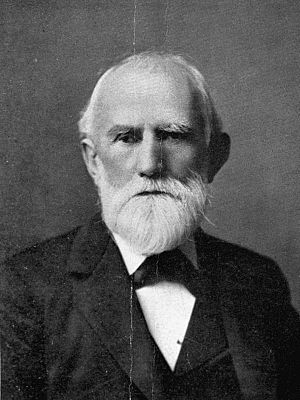George Washington Scott facts for kids
Quick facts for kids
George Washington Scott
|
|
|---|---|

State Archives of Florida
|
|
| Born | February 22, 1829 |
| Died | October 3, 1903 (aged 74) |
| Resting place | Decatur Cemetery Decatur, Georgia |
| Occupation | Businessman, Planter |
| Political party | Democrate |
| Spouse(s) | Rebekah Bucher |
| Military career | |
| Allegiance | |
| Service/ |
|
| Years of service | 1861–1865 |
| Rank | |
| Unit | |
| Battles/wars | American Civil War |
George Washington Scott (born February 22, 1829 – died October 3, 1903) was an important businessman and farmer in Florida. He also served as a military officer during the American Civil War. Scott later became known for his work in the fertilizer industry and for helping to create Agnes Scott College.
Contents
Early Life and Moving to Florida
George Washington Scott was born in Alexandria, Pennsylvania on February 22, 1829. He was the fourth child of Agnes Irvine and John Scott Sr. His family had Scottish roots.
As a young man, Scott worked as a merchant and farmer in Pennsylvania. In 1850, he visited Florida. He liked it so much that he decided to move there. In 1851, he settled in Quincy, Florida.
A year later, in 1852, Scott moved to Leon County, Florida. There, he started a business where people could trade goods. He also set up his own large farm, known as the George W. Scott Plantation.
Military Service in the Civil War
When the American Civil War began, George Scott joined the military. In 1860, he signed up with the Tallahassee Guards, a local group in Leon County.
When the Confederate States of America was formed, Scott became a Captain. He led Company D of the Second Florida Cavalry. In 1863, he helped create the Fifth Florida Cavalry Battalion. He was elected as its lieutenant-colonel.
Scott's unit was often called "Scott's Cavalry." They served in central and eastern Florida. They fought in the Battle of Olustee in February 1864. They also took part in battles near Jacksonville, Florida.
In March 1865, Scott and his soldiers played a big part in the Battle of Natural Bridge. This battle happened south of Tallahassee. Their actions stopped Union forces from taking over the state capital. Scott's unit surrendered and was released in Tallahassee in May 1865.
Life After the War
After the Civil War, Scott tried to enter politics. In 1868, he ran for governor of Florida as a Democrat. He had a lot of support from the people. However, because Florida was under Northern control at the time, Scott was not allowed to take the position. He was actually relieved, as he had not wanted to be a candidate in the first place.
Farming and Fertilizer Innovations
On his plantation, Scott liked to try growing different crops. He planted 12 acres (about 48,500 square meters) of sugar cane. He also grew vegetables like cabbage, collards, rutabagas, and Dutch turnips.
Scott was very clever with his farm. He built a 16-foot (5 meter) overshot waterwheel. This wheel moved water from a pond to help process his corn, sugar, and cotton.
Scott also invented a new kind of fertilizer. He mixed cottonseed with bone meal. To get bones, his farm workers collected animal bones. They earned cane syrup for every 100-pound sack of bones. The bones were crushed using a heavy cast-iron stamp powered by the waterwheel. This bone meal was then mixed with sulfuric acid and cottonseed cake to make his special fertilizer.
Business Success in Georgia
In 1870, Scott sold his plantation in Florida. He moved to Savannah, Georgia, and then to Atlanta. In Atlanta, he built a very successful business. By 1887, his company, the George W. Scott Company, made a fertilizer called Gossypium Phospo. It became one of the most famous fertilizers in the Southern United States.
Scott was also the first person to use Florida's large phosphate deposits. Phosphate is a mineral used in fertilizers. In 1887, he bought 1,000 acres (4 square kilometers) of land along the Peace River in Charlotte County, Florida. He also supported the Arcadia Phosphate Company. He sold fertilizer to the Comer-Hall Fertilizer Company in Savannah. In May 1888, the first shipments of phosphate were sent to his G. W. Scott Manufacturing Company. Scott became very wealthy from real estate and fertilizer in Atlanta.
Legacy and College Founding
In 1890, George Scott gave $112,250 to the Decatur Female Seminary. He had helped to start this school for girls in Decatur, Georgia. The school was later renamed Agnes Scott College in honor of his mother, Agnes Scott.
George Washington Scott passed away on October 3, 1903. He is buried in the Decatur Cemetery in Georgia. The city of Scottdale, Georgia is named after him.

